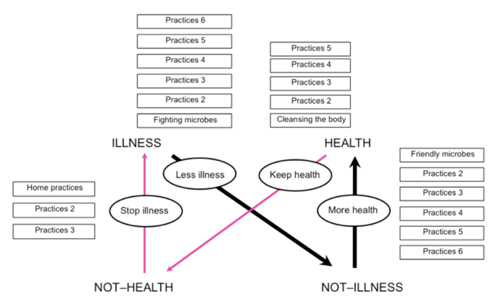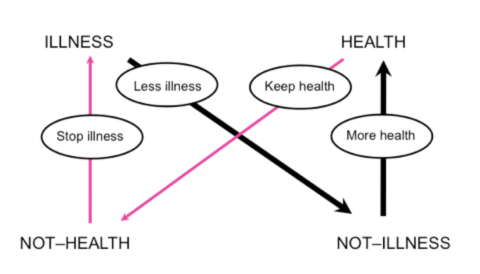Krzysztof Polak
Creating a pharma product portfolio using semiotics.
Creating a pharma product portfolio based on cultural categorisation instead of product substance types is crucial in the modern-day marketplace. Today’s consumers are driven by popular health culture present in different types of mass media: colour magazines, TV programs, films, internet sites, etc.
Pharmaceutical companies become more and more aware of popular health culture influence on consumers’ decisions: their perceiving and choosing pharma products, their approach to illness and health. Brand managers start looking around for solutions, which can help their brands to be more culturally relevant.
One of these companies came to us with a general need to explore the popular culture around illness and health. They wanted to better understand cultural drivers and practices around the phenomenon. Finally they asked us a question how is it possible to create a culturally relevant product portfolio.
A portfolio based on product forms is very typical in the pharmaceutical category. Products are usually grouped by their substance, for example syrups, lozenges, capsules, ointments and so on. Sometimes this type of categorization is enhanced through types of illnesses like medicines for flu, for sore throat or for headache.
Our task for the pharmaceutical client was to find out the possible cultural criteria to organize products and in the end to be more culturally relevant with portfolio proposition.
Having such a goal we started with a quite simple question: What is going on in health/illness culture? What type of discourses, kinds of language, categories of visual representation and types of health practices are present in that area?
We analysed a big range of cultural sources; guidebooks and compendia about health, medical advice in magazines, websites on healthy living, blog discussions, popular texts about medicine and of course TV and print ads of pharma products. We analysed current and historical cultural sources. Both were necessary to understand what are the main changes in the illness/health culture.
The first general finding was that the meaning of health has really changed: in yesterday’s culture “to be healthy” just meant “not to be ill”. Today’s meaning of health is much wider and means “more health”. It is connected with life energy, optimism, vitality, superbody, supermind, etc. Health became a new ideology represented through such phenomena as Well-being or LOHAS. Health is strongly related to a happy life and even to happiness: living in harmony with nature and other people, developing inner balance. On the other side to be healthy means to have unusual body and mind efficiency.
The wider meaning of health caused a wider meaning of oppositional states. This is especially visible in the notion “not-healthy”. It has widely spread in food category and life styles. We have unhealthy fats, sugar, artificial food colouring, unhealthy habits, etc. However do something in unhealthy way or to be unhealthy does not mean “to be ill”. According to the “not-healthy” rhetoric it is important to “remove” bad elements from our food and our body of course.
This was the moment we decided to use semiotic square to organise existing meaning structure of health and illness. The semiotic square is a quite powerful tool in this regard. It can help with categorisation of different aspects of cultural meanings and could help to create a product portfolio, which taps into today’s culture. It can be used in different kinds of marketing analysis: category mapping, brand positioning, brand meaning map, etc.
In the beginning we used a quite obvious scheme of the semiotic square based on the opposition illness vs. health. Before we go further it is a good moment to explain the semiotic square concept. Algirdas Greimas, who adopted the logical square of scholastic philosophy, introduced it in 1966. For him the square represents the elementary structure of meaning.
Jean Marie Floch – French semiotician, who first used the semiotic square in marketing analysis, gave an excellent and simple explanation of how it works. He recalls a situation of two people discussing good and bad.
While discussing, participants concluded that it is not possible to understand the idea of good without idea of bad and vice versa. Both notions are relative. However during the discussion both disputants notice that there are notions like “not-bad” and “not-good”. “Not-bad” is not the same as “good” and “not-good” is not the same as “bad”. So it is necessary to include these notions to have a complete understanding of good and bad. This is an example how elementary structure of meaning is created through the four elements of the semiotic square.
The semiotics square for illness and health
During our research we realised that this square does not only represent a structure of meaning but is the scheme of a continuous and never-ending road to health. There are, in culture, many visual and verbal representations of health expressed through the idea of a road. For example: “signpost to health”, “way to health”, “run for health”, etc. The semiotics square in this case shows the “road to health” with directions from point to point. There are four important paths:
What is important there is no straight road from illness to health in today’s culture. There was in the past, when “to be healthy” just meant “not to be ill”. Proposed diagram represents stops on the road and four different types of practices involved in the “road to health”… and eventually types of medicine, which help in a particular process.
The first path – from illness to not-illness is about getting rid of illness through fighting microbes, quick removal of bad agents, fixing the body, etc. It suggests creating one portfolio group and devoting it to the quick support of disease removal.
The second path – from not-illness to health is about adding good factors like good fats, probiotics, friendly microbes, enhanced functionality of vital organs, creating internal balance and harmony with nature. This group in the portfolio should consist of products concentrated on adding more health, more vitality and more life energy.
The third path – from health to not-health is about keeping the good and protecting health by avoiding bad factors like stress or bad fats, supplying micro-elements, cleansing the body, etc. It prompts us to create a group of products intended to keeping the good and considering situations when we are in a state of health but afraid of a possible state of not-health.
The fourth path – from not-health to illness is about stopping the spread of bad factors and not allowing our body to pass into the state of illness. The practices are concentrated on recognising the enemy (illness), using natural and home practices, recognizing symptoms and to act against them. It implies that a group in the portfolio should be devoted to aborting the progress of the illness.
Finally our semiotic square looks like this (some elements have to be hidden, sorry):
 This semiotic square of illness and health suggests us to create four main groups of pharma products:
This semiotic square of illness and health suggests us to create four main groups of pharma products:
- Products about disease removal
- Products about adding more health
- Products about keeping the health
- Products about aborting the progress of the illness
Inside of the each of above groups we identified subgroups. For example there is a subgroup in the first group we called “fighting microbes”. Organising our product portfolio in cultural way we can put inside this subgroup products for microbes extermination. It is important that the packaging, slogans and ads should appeal to the symbolic of fight and war to be consistent.

Another example can be a subgroup “cleansing the body” inside the third group. Generally this group is about keeping the health – cleansing is one of this type practices presented in culture. In our product portfolio we can create the subgroup appealing to the keeping body clean as an important factor of keeping good health. There are such signifiers as light blue or green colours, water and waves, transparent colours, fresh nature pictures.

As you can see on the final diagram we identified twenty cultural practices and four main groups in the popular health/illness culture. We suggested our client to create pharma product portfolio in the same way. There are three important benefits to do this from our perspective:
To keep cultural relevance at organisational and product level. Brand team = product group = cultural practices and meanings. Usually there is no straight connection between product team and culture. Organising products in the cultural way forces organising product team in the same way.
To keep consistency on the each level of product. Product type > packaging > communication > culture. Products are organised around cultural ideas, practices and signs. It forces to be consistence in meanings instead of substance or type.
To keep changing all the time. There is no way to be culturally relevant without tracking the change. Cultural categorisation of product portfolio needs to be continuously revised. So it forces the searching and change not only on communication but organisational level too.
Krzysztof Polak is a partner at Semiotic Solutions



